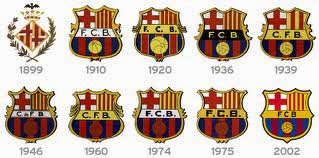On 22 October 1899, Joan
Gamper placed an advertisement in Los
Deportes declaring his wish to form a football club. A positive response
resulted in a meeting at the Gimnasio
Solé on 29 November. Ten players attended: Walter Wild, later to become the
first director of the club, Lluís d'Ossó, Bartomeu Terradas, Otto Kunzle, Otto
Maier, Enric Ducal, Pere Cabot, Josep Llobet, John Parsons and William Parsons.
As a result, Football Club Barcelona was born. The blue and red colours of the shirt were
first worn in a match against Hispania in 1900; the prevailing Catalonia
conception is that the colours were chosen by Joan Gamper and are those of his
home team, FC Basel.
FC Barcelona quickly emerged as one of the leading clubs in
Spain, competing in the Campeonato de Cataluña and the Copa del Rey. In 1902,
the club won its first trophy, the Copa Macaya, and also played in the first
Copa del Rey final, losing 2–1 to Bizcaya.
In 1908, Joan Gamper became club president for the first
time to save the club from bankruptcy. The club had not won since the
Campeonato de Cataluña in 1905; this caused their financial trouble. One of his
main achievements was to help Barcelona acquire its own stadium and thus
achieve a stable income.
On 14 March 1909, the team Marca Hispanica moved into the Camp
de la Indústria, a stadium with a capacity of 8,000. To celebrate their new
surroundings, a logo contest was held the following year. Carles Comamala won
the contest, and his suggestion became the crest that the club still wears as
of 2012, with some minor changes.
With the new stadium, Barcelona participated in the
inaugural version of the Pyrenees Cup, which, at the time, consisted of the
best teams of Languedoc, Midi and Aquitaine (Southern France), the Basque
Country and Catalonia; all were former members of the region. The contest was
generally considered the most prestigious in that era. From the inaugural year in 1910 to 1913,
Barcelona won the competition four consecutive times. Carles Comamala played an integral part of the
four-time
champion, managing the side along with Amechazurra and Jack
Greenwell. The latter became the club's first full-time coach in 1917.The last
edition was held in 1914 in the city of Barcelona, which local rivals Espanyol
won.
During the same period, the club changed its official
language from Castilian to Catalan and gradually evolved into an important
symbol of Catalan identity. For many fans, participating in the club had less
to do with the game itself and more with being a part of the club's collective
identity. On 4 February 1917, the club held its first testimonial match to
honour Ramón Torralba who played from 1913 to 1928. The match was against local
side Terrassa, which Barcelona won 6–2.
Gamper simultaneously launched a campaign to recruit more
club-members, and, by 1922, the club had more than 20,000, who helped finance a
new stadium. The club then moved to the new Les Cortes, which they inaugurated
the same year. Les Cortes had an initial capacity of 22,000, and was later[when?]
expanded to 60,000.
Gamper recruited Jack Greenwell as the first full-time
manager in Barcelona's history. After he was hired, the club's fortunes began
to improve on the field. During the Gamper-led era, Barcelona won eleven Campeonato
de Cataluña, six Copa del Rey and four
Pyrenees Cups and enjoyed its first "golden age".


No comments:
Post a Comment